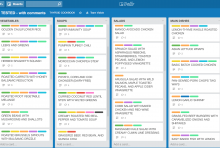The Making of a Cookbook: Recipe Creation

This post was written by Lisa Markley, MS, RDN, who, along with Jill, co-authored the #1 best selling Essential Thyroid Cookbook.
I’m sorry (not sorry) if we’re starting to sound like a broken record, but we just can’t say thank you enough to everyone who has pre-ordered The Essential Thyroid Cookbook. You’ve helped us set it up for successful rankings and we really appreciate your backing.
We’ve worked so, so hard on every piece of the book and publishing process and we’re anxious for you to experience the fruits of our labor when you receive your copies this week!
Many people have asked what happens “behind the scenes” in making a cookbook, so today I’m sharing a bit about how these recipes came to be…my creation and testing process.
Having never written a cookbook before, there was quite a bit of trial and error to figure out a process that worked well for me, our testers, and the book. My process was far from linear, as most creative processes aren’t, but I’ve done my best to outline it below.
Recipe Inspiration, Research, and Development
When Jill and I began our journey with this cookbook, I was teaching frequent cooking classes at Whole Foods Market. In fact, the last time I counted the number of classes and demos I taught over the 6+ years I worked in their kitchens, it was over 300 – during that time I became an expert at slinging small plates and washing dishes!
Over the years of teaching, I learned to adapt recipes or create original recipes for my classes utilizing ingredients that I wanted to feature based on seasonality and peak flavor, what was on sale, cooking technique, or more specifically on their nutrition and health benefits. Oftentimes, all of these factors were combined into my menus.
Much of this translated over to my method of creating over 100 original recipes for our cookbook. Taking the ingredients highlighted in our diligently researched Nutritional Springboard, I drafted a list of recipe ideas I wanted to develop, combining these ingredients in the most flavorful ways possible.
Our ultimate goal was to have every recipe be a dense source of at least five key nutrients known to support thyroid and immune function, as illustrated on our springboard.
Recipe Testing
Once I had recipes ready to start testing, I reached out to the inimitable Tess Masters, The Blender Girl for advice on how to set up my process.
Her expert wisdom and insights proved to be invaluable in helping me organize the recipes for easy sharing and tracking with our testers. Tess suggested I set up a Trello account where I could post my recipes to a private board. Once I got things set up, I invited our testers into this private space.
Who were our testers?
Jill and I reached out to several close friends, family members, colleagues, and clients and asked them to participate in recipe testing. Some with Hashimoto’s, some without. Some with families, some single or cooking for themselves and their significant others. Some with a lot of cooking experience, some without. We had just over 30 testers generously contributing their time and their taste buds to our cookbook.
What was the testing process like?
Testers were given access to all of the recipes on my Trello board, which ended up being over 130 recipes. I set them up by category (e.g. breakfasts, appetizers, beverages, main dishes, etc.) and instructed testers to test any recipe that interested them.
Over the course of several months, every recipe was tested by myself plus at least two additional testers. They provided the following feedback in the comments section below each recipe:
• How does it look?
• How does it taste?
• Were the preparation/cook times accurate?
• Was the number of servings yielded accurate?
• Did the directions make sense? Were they easily understood or was there any confusion?
• What (if any) improvements do you think are needed?
• General overall impression: like, love, just okay, don’t like it? Would you make this again?
As I received feedback, I remade the recipes that needed to be corrected or tweaked at least one more time (but often more) then recorded the adjustments that were made.
Their time and honest feedback helped me hone in on the recipes that proved to be the most popular (Flourless Triple Chocolate Walnut Brownies, anyone?!) and the ones that could be cut.
Editing
Once all of the recipes were cleaned up, they were transferred into a Word document where I added intros and listed key nutrients. We hired Nikki Croes, culinary writer, trained chef, and editor at Intuition Kitchen Ink as our editor.
She and Jill went through my near final recipes with a fine-tooth comb looking for inconsistencies in formatting or unclear instructions. It was eye-opening to discover how much I had missed! When you’re so close to your work sometimes you have to take a step back and learn to see things through another lens.
Nikki and Jill’s thorough feedback helped me to create consistent style guidelines so all of my recipes had similar flow. The editing process went through several rounds. I am so grateful for their attention to detail – it really helped me tighten things up, ultimately making the recipes more user-friendly for you, the reader.
As they say, it takes a village. And Jill and I are so grateful for the village of people who have helped us bring this cookbook to life!
[Insert Jill’s comment: Likewise, for the educational component, I was so close to it and Lisa went through it with a fine-toothed comb and helped me see things through a different lens. Her editing and advice was indispensible in making everything flow and be as clear and reader-friendly as possible!]
The Essential Thyroid Cookbook pub date: September 19
Add comment